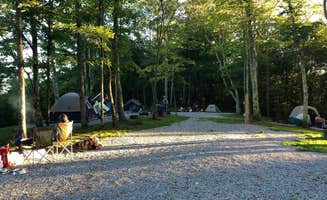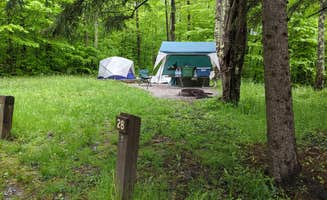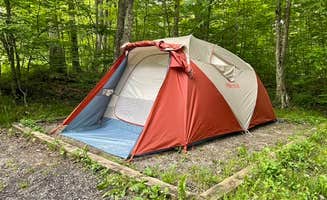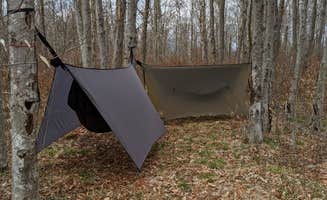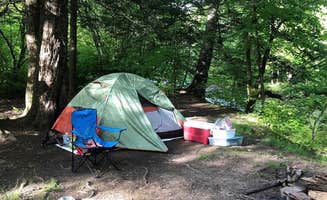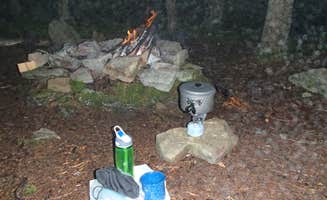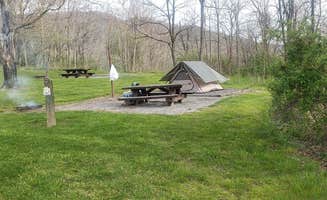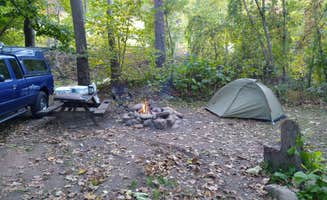Camping sites near Circleville, West Virginia range from primitive dispersed options to established campgrounds situated within Monongahela National Forest. Winter camping in this region requires special preparation as temperatures at higher elevations (4,000-4,800 feet) can drop below freezing even in early fall. Most campsites have fire rings, though some remote areas require campers to follow strict leave-no-trace practices when building fires.
What to do
Tubing the river loop: At Big Bend Campground, the South Branch Potomac River creates a natural lazy river surrounding the campground. "It's a great place to take a day trip to for fishing or site seeing. They have an awesome wooded hiking trail that goes around the entire lake approximately 1 mile long," shares Adam W. The full river loop takes about an hour to float, with just a 2-minute walk back to restart.
Backcountry hiking: For more challenging trails, explore the Huckleberry Trail near Spruce Knob. "We parked at the summit, descended down and came back up. It was one of the most gorgeous trails I've ever experienced and highly recommend it for a quick weekend backpack," notes Emily S. Several established backcountry camping spots can be found along this trail for overnight hikers.
Night sky viewing: With minimal light pollution, Spruce Knob Lake Campground offers prime stargazing opportunities. "You're in the middle of nowhere, so you do have a truly dark sky," explains Jean C. Bring a telescope or simply lay back to view the Milky Way, especially visible during new moon phases.
What campers like
Creek-side sites: Many campers praise the waterfront locations at Gandy Creek Dispersed Camping. "We picked a spot about halfway into the dispersed camping area, creek side along the Gandy creek. The only others we saw from our campsite were people fishing downstream from our camp and they were respectful of our space," reports Melanie S. Sites along the creek offer natural white noise for sleeping.
Site privacy: At Gandy Creek, "Some you walk-in a short distance but are rewarded with amazing sites on the creek, secluded and wooded. Other places you can camp in your vehicle or park at the site. My favorite areas are on the creek. Lots of privacy, every site is unique and special in its own way," explains Jennifer R. The free dispersed sites can be occupied for up to 14 days.
Cooler temperatures: The high-elevation campsites provide relief from summer heat. "Even when it's hot it's a great place to camp because the elevation and the creek," notes Jennifer R. about Gandy Creek. This natural air conditioning makes the area popular during July and August when valley temperatures soar.
What you should know
Cell service limitations: Throughout the region, connectivity is extremely limited. "Download your maps before you come, because there's no cell service and you'll truly get away," advises Jean C. about Spruce Knob Lake Campground. At Big Bend, "No cell service. Nearest cell reception is a 20 minute drive away," adds Jon C.
Road conditions: Access to some campgrounds requires navigating unpaved roads. For Island Campground, "Just getting to Laurel Fork Campground is a backwoods, seemingly endless gravel road journey. So something tells you…this is gonna be good spot. Its out there…I mean, really out there," explains Dave V. High-clearance vehicles are recommended for some areas, particularly after rain.
Limited supplies: Most camping areas have minimal services. "Make sure you have what you need because it's a long way to a spot to resupply!" warns Jean C. The closest stores to many campgrounds are 30+ minutes away, and many close early or have limited hours during off-season.
Tips for camping with families
Swimming spots: Brandywine Lake Campground offers kid-friendly water access. "I love this campground because they have showers & toilets there, a fun beach on the lake for swimming and a fishing dock as well," shares Rachel B. The designated swimming area provides a safer alternative to the sometimes swift-flowing creek waters.
Wildlife education: Many campsites provide opportunities to observe local fauna. "Chipmunks everywhere you look and incredible sunrise birdsong," reports Erica H. about Seneca Shadows. Morning and evening hours are best for wildlife viewing, with deer commonly spotted at dusk.
All-weather options: Have backup plans for rain. "In mid April the campground had plenty of space, but nearby Spruce Knob Lake was encircled by fishers seeking trout from the latest release," notes Jean C. Fishing remains a popular activity even during inclement weather, and nearby visitor centers provide indoor alternatives.
Tips from RVers
Site selection considerations: At several campgrounds, the layout can be challenging. "Many of the pull thru sites are situated in the wrong direction with the electric hookup on the wrong side. The dump station is in a weird spot and the only water available is the same used for flushing," cautions Kevin E. about Blackwater Falls State Park Campground.
Leveling preparations: Bring additional leveling blocks as many sites feature slight grades. "The campground is a short drive from Seneca Rock. Wind back into the woods for camping in a quaint quite setting (A-D) or camp in the meadowlands with Seneca Rock in the background (walk-sites)," advises Jillian E. about Seneca Shadows. Sites in sections A and B are reported to be more level than other areas.
Weather considerations: RVers should be prepared for rapid weather changes. "If you're going to camp at this campground I would totally recommend doing the Huckleberry Trail at the summit!" suggests Emily S. The higher elevation means cooler nights and more precipitation, so awnings and proper ventilation are essential.



